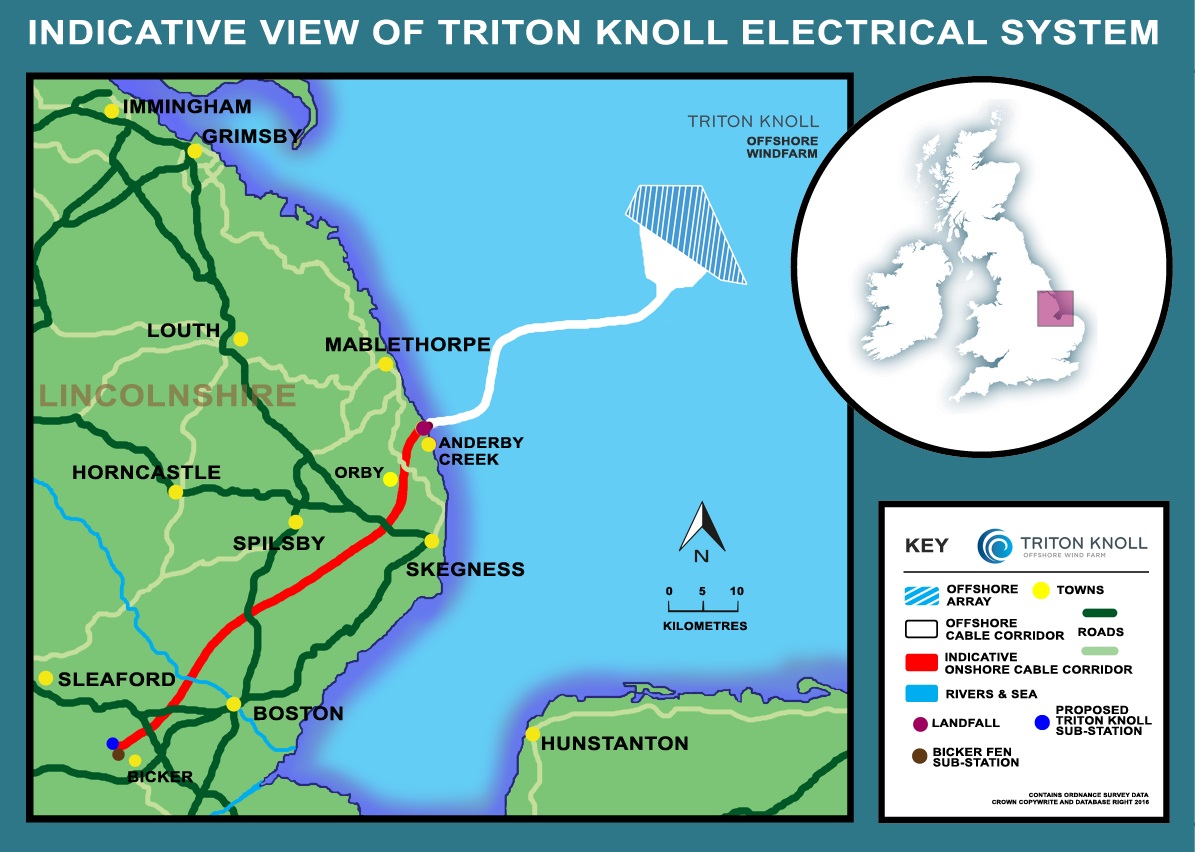Triton Knoll is an 857MW ‘Round 2’ offshore wind farm, owned by RWE (59%), J-Power (25%) and Kansai Electric Power (16%). RWE managed the construction phase of the project and is also responsible for operating and maintaining the wind farm from it's state-of-the-art facility located on the North East coast, the Grimsby Hub.
Project statistics
| Installed capacity | 857 MW |
| No. of turbines | 90 x MHI Vestas v164-9.5 MW turbines |
| Approximate tip height of V164-9.5 MW turbine | 187 m (NB; consent granted for maximum installed blade tip height up to 220m) |
| Potential no. of average homes supplied annually | At least 935,000 average UK households1 |
Location

Triton Knoll is within the Greater Wash strategic area, located off the east coast of England, approximately 20 miles off the coast of Lincolnshire and 28 miles from the coast of north Norfolk. This is one of three 'Round Two' strategic areas around the coast of Great Britain, which were released for offshore wind development by The Crown Estate and the Government in 2003.
Offshore and onshore electrical infrastructure connects the wind farm to the electricity network. Sub-sea export cables from the offshore wind farm make landfall just north of Anderby Creek, with the power entering the electricity network at the National Grid Bicker Fen Substation, near Boston, via a network of underground cabling and new onshore substation.
Project Background
At the time of the Round 2 tender process, RWE Renewables (at the time called RWE npower renewables) was awarded a license to develop an offshore wind farm called Triton Knoll up to a maximum of 1,200 megawatts (MW). Triton Knoll was consented in two separate applications (the Offshore Array and the Electrical System), but was constructed and is being operated as one project. Triton Knoll was successfully awarded a Contract for Difference by the Department for Business, Energy & Industrial Strategy, in September 2017 and it achieved Financial Close in August 2018. Onshore construction commenced in September 2018 and was successfully completed in October 2021. Offshore construction commenced in January 2020 and the final wind turbine was successfully installed in September 2021. Turbine commissioning was successfully completed to programme in January 2022 and the project is now fully operational.
Triton Knoll consists of two Development Consent Orders detailed below:
1 – The electrical system
The Triton Knoll Electrical System includes the onshore substation, underground cables and the offshore export cables. An application for a Development Consent Order for the electrical system was submitted and accepted by the Planning Inspectorate in 2015. Following a full examination, consent for the electrical system was granted on 3 September 2016. In December 2023, Triton Knoll Offshore Wind Limited successfully completed the sale of transmission assets to Triton Knoll OFTO Limited, owned by ETEPCO, a consortium of Equitix Limited and TEPCO Power Grid Incorporated.
The Triton Knoll Offshore Array includes the 90 x wind turbines, meteorological masts, offshore substations and the cables that link the wind turbines to the offshore substations. The Secretary of State for Energy and Climate Change granted consent for the offshore array on 11 July 2013.
Decommissioning
Consultation on a draft Decommissioning Programme ended on 25 January 2019, with all comments received being reviewed to support the final decommissioning plan. An updated Decommissioning Programme will submitted to the government’s Department for Business, Energy and Industrial Strategy and, once approved, will be available to view on this page.
Calculation based on 2021 generation, and assuming average (mean) annual household consumption of 3,509 kWh, based on latest statistics from Department of Energy Security and Net Zero (Subnational Electricity and Gas Consumption Statistics Regional and Local Authority, Great Britain, 2021, Mean domestic electricity consumption (kWh per meter) by country/region, Great Britain, 2021)
